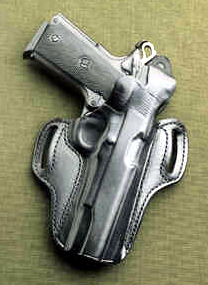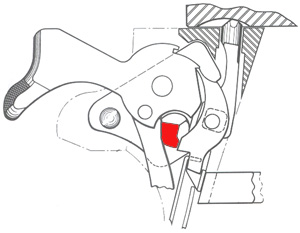
My brother recently acquired a Colt Commander. He had put a Federal hollowpoint in the chamber and lowered the hammer (condition #2). He was holstering the pistol with the hammer down. This was a holster with a thumb break. As he attempted to adjust the pistol in order to snap the thumb break closed, the pistol discharged. The round traveled into his upper right butt cheek and out the bottom, about 6 inches below his butt cheek. The round didn’t expand and fell to the floor under the weight of gravity alone. He is fine now but the AD [accidental discharge] perplexed us a lot until we figured that the hammer was resting on the firing pin, and the soft primer Federal hollowpoint round and the hard “snap” of the new holster hit the hammer hard enough to touch off a round. Fixing the issue is to simply not chamber a round, period.
Thank you for sending in this incident report and I’m glad that your brother is OK. After conferring with a couple of my gurus, we agree that your analysis is entirely possible. With the hammer down on a live round, the force involved with forcing down the thumb break could set off a sensitive primer, especially if the force was applied quickly. Thumb break holsters for the 1911 are designed to fit “condition one” guns – hammer cocked and safety locked. The thumb break then fits securely around the rear of the slide. In addition to the internal safeties of the gun, the thumb break provides an additional barrier to an accidental discharge because it fits between the hammer and the firing pin. This incident provides yet another illustration of why I don’t like condition two carry – hammer down on a live round. On a genuine 1911 there is no firing pin block and it is possible for a condition two gun to go off if it receives an impact on the hammer.

There is another possibility here, and that is that the gun was actually in a “false half-cock” condition. It is possible on some guns to lower the hammer so that it stops with the end of the sear against the point of the half-cock hook rather than being trapped within the half-cock notch. It has been shown in testing that a hammer falling from half-cock will set off a live round about 40% of the time. It is possible that your brother actually lowered the hammer to this “false half-cock” condition and the force of trying to snap the thumb break over hammer caused it to slip and thus allow the hammer to fall from half-cock. [In the diagram, the half-cock hook is the uppermost hook which is nearest to the hammer stem. The sear is the crescent-shaped piece which sits in front of the hammer.]
The only place I disagree with you is in your conclusion that the only safe way to carry a 1911 is with an empty chamber. I think that the safest way to carry a 1911 is condition one – hammer cocked and safety locked. In an absolute sense, condition three or condition four is “safer” from the point of view of accidental discharges, but these are not safer in terms of the gun performing the function for which it is intended. Racking the slide to load the gun during the draw is considerably slower than sweeping off the thumb safety, and in an emergency it could make the difference between life and death. For more of my thoughts on this, please see “Is ‘Cocked and Locked’ Dangerous?” An alternate way of dealing with this problem is to use gun with a firing pin block such as Series 80 and later Colts or Series II Kimbers.

Comments, suggestions, contributions? Let me know